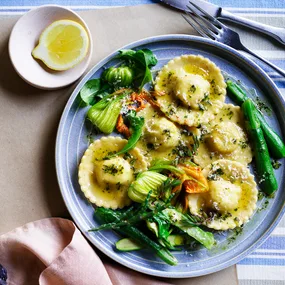Spain’s most famous food export, paella, has reached the four corners of the globe, but sadly bears little resemblance to its original form. The original paella would never have included a combination of meat and seafood, let alone peas, red capsicum or chorizo. This modern interpretation would be unrecognisable in the dish’s birthplace, Albufera, a lakeside region south of Valencia. Here, it was more likely to include hunks of rabbit or chicken and a handful of seasonal vegetables – broad green or pale yellow beans, tomato, saffron and onion. It was just as likely to include snails, said to deliver a hint of the rosemary which formed the basis of their diet.
Paella is all about simplicity: it is not a dumping ground of ingredients. It is, above all, a rice dish, and it’s the quality of the rice that must shine. The only exception is fideuá, a paella made with fideus noodles, similar to vermicelli pasta, rumoured to have been created by fishermen at sea without access to rice. A true paella calls for a short-grain rice, which has the ability to absorb cooking liquid and form a crust while retaining its shape. Calasparra is the most common paella variety available here.
As with all classics, paella varies from village to village and even from household to household. Some say true paella Valenciana must be cooked outside over a fire made of orange branches, dished up with a boxwood spoon and eaten only at midday. In his book Catalan Cuisine, Colman Andrews goes one further and writes that for men cooking and sharing paella, the only acceptable topics of conversation are “women, bullfighting and crops”.
Andrews gives three rules to follow when making a paella: never stir it once the rice has been added and never add more liquid than is called for (if the paella is drying out too quickly, reduce the heat; if it’s too soupy, increase the heat). Lastly, always let the paella rest for five to 10 minutes before serving.
Paella should only ever be cooked over the stove, never in the oven, and is eaten straight from the pan, making it the perfect communal dish. While it can be made in a frying pan, it’s a good idea to invest in a caldero, or paella pan. Its shape gives the largest possible surface area to create the highly prized crust, or socarrat, on the base. Calderos are made from iron and should be seasoned like a wok; rubbed with oil and cooked over high heat until black, then wiped out with a cloth or paper towel to remove any residue until the pan wipes clean. To prevent rust developing, always wash the pan with warm water, dry it thoroughly and rub it with oil before storage. The enamel version won’t require this level of care but produces an inferior crust.
Next time you set out to make a closer-to-authentic, rustic paella, forget the shellfish, and let the hearty flavours of saffron, meats and seasonal vegetables sing.
Ingredients
Method
Main
Calasparra rice is a short-grain Spanish rice available from Simon Johnson and Spanish delicatessens.
Notes










